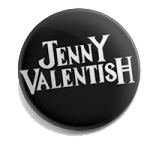Jen Jewel Brown
For Time Out Melbourne I interviewed Jen Jewel Brown, who cut her teeth on Daily Planet – Michael Gudinski and Michael Browning’s counter-culture music paper – and went on to rule at long-form rock journalism, including writing a bio about Skyhooks that sold 20,000 copies. Unthinkable! Journos, you’ll be bellyaching “Jeez, that wouldn’t happen these days” all through this interview.
Jen Jewel Brown made her name as a counter-culture journalist at a febrile time when frontiers were being breached and flags planted.
“People still want to talk to me about it,” she acknowledges, settling down for a coffee with Time Out at her local Fitzroy North café Piccante, “because there’s an increasing fascination with the ’70s and ’80s; that rich period of growth and culture in Australia.”
These days, the writer has become the written about, as while Jen’s in demand as a music historian in both print and radio, she’s equally as often asked to talk about her own experiences shaping the landscape of contemporary Australian music.
Jen, let’s really start from the beginning. Where were you born and raised?
I was born in North Balwyn on 12th February 1952. The house was the first house on the block and it was designed by my father and Robin Boyd, the Melbourne architect, and my dad built it. He was a consulting engineer and surveyor. My mum looked after us and she was a school teacher. She was also one of the first media teachers and somewhat pioneered that world of teaching. She was the first editor of Metro magazine. So, me and the other three kids were seeped in a lot of culture through Mum, particularly film. My music passion was not really reflected in my parents’ world, Dad thought this jive music was completely despicable. He did have good taste in terms of Frank Sinatra, Cole Porter, Peggy Lee and these great singers and songwriters, but he hated rock’n’roll. Dangerous, dirty, drugs! Untrustworthy with your eldest daughter.
Do you think that put you on a path of rebellion?
Yes. I wasn’t allowed to go out at all. All I wanted to do in life was go out and see the Loved Ones and Masters Apprentices and bands like that and I couldn’t. So about around the time I was 16 I started going out of the window at night to the nearest club, called Q Club in Kew. It took me nearly 40 minutes to get there by walking and occasional trams. As I was growing up through the ’50s and ’60s, North Balwyn was socially isolated. There are some music people that I’ve discovered come from that area: Rick Dempster was a good blues and roots harmonica player who is still around and also Kirk Pengilly from INXS grew up there. He played with his fellow Almond Street friend Michael Sheridan, who ended up in some of Ollie Olsens’ bands including NO and Max Q with Michael Hutchence. So there were certainly some musical people there but they were kids growing up in nice suburban families in the ’60s and there was nothing to do locally at night.
What was your first job?
I think I had one day in a shop called Bath and Boudoir in Toorak Road, where I got fired for having messy hair. After that I answered an ad in Daily Planet and they were looking for freelance writers. I was a poet at that time, a drop out; hadn’t finished school and didn’t know what I wanted to do. My mother used to throw the classified ads at me every morning to try and get me out of bed.
They would have wanted you to go to uni, I would have thought.
Yes, they would have liked me to go to uni, but I had no interest at all at that point. So, I was very, very pleased when Daily Planet decided to give me a go. They let me start as a freelancer and I continued freelancing elsewhere after that time. I was about 19 and I thought Daily Planet was fabulous. It was a counter-culture music paper started by Michael Gudinski and his partner-in-crime then, Michael Browning, who later became the first manager of AC/DC. There was a succession of editors, some of whom were sourced through Billy Thorpe’s road crew, and lots of musos. I was still wet behind the ears and my main skill was writing poetry, but we got it all together and there was a lot of writing about areas like folk, hard rock, blues – things that weren’t getting covered in Go-Set, the pop-focused paper of the day.
This was a period when it was common to find signs backstage at gigs saying “No women allowed”. Do you think there was any tokenism in them hiring a woman?
I think they were glad to have a young woman in the office actually. They had another young woman, Susie Cassio, who was essentially the typesetter but in the end was responsible for making sure everything came out on time, and she was very efficient. She ended up editing the Melbourne Times amongst other things. And there were other female writers that came in. Go-Set also had some and later RAM magazine, but these magazines had more female writers than the media around them. It was a very masculine landscape and certainly the rock’n’roll band landscape, you could look very hard to find two percent of women in the business and on-stage.

